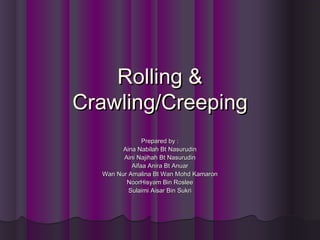Mat activities-Rolling & crawling (2)
- 1. Rolling & Crawling/Creeping Prepared by : Aina Nabilah Bt Nasurudin Aini Najihah Bt Nasurudin Aifaa Anira Bt Anuar Wan Nur Amalina Bt Wan Mohd Kamaron NoorHisyam Bin Roslee Sulaimi Aisar Bin Sukri
- 2. Rolling
- 3. Introduction ’ü¼ Definition: Move forward along a surface by revolving on an axis or by repeatedly turning over ’ü¼ It requires a certain level of control over the head, neck and trunk
- 4. Therapeutic Goals of Rolling ’ü¼ Strengthening of trunk muscles ’ü¼ Increasing the patienŌĆÖts ability to roll ’ü¼ Mobilizing the trunk, scapula, shoulder , hip
- 5. Human development sequence of rolling ’ü¼ ’ü¼ ’ü¼ ’ü¼ 2 months - the first sign of voluntary rolling appear with the infant turning from its side to its back. 4 months - the infant can roll from a supine position to the side and from the prone position to the side. 6 months - the infant matures and gains greater control of the hips and shoulders,more advanced abilities such as rolling from supine to prone. 8 months - the most difficult task, rolling from the prone to the supine position.
- 6. Mat Activities ’ü¼ The mat program involves the patient in activities incorporating both movements and stability ’ü¼ They range from single movements to complex combinations requiring both stabilization and motion ’ü¼ The activities are done in different positions for function and to vary the effects of reflexes or gravity
- 7. Mat activities of rolling ’ü¼ Rolling is both a functional activity and an exercise for the entire body ’ü¼ Rolling occur because of facilitation from the scapula or pelvis. ’ü¼ Combinations of scapula, pelvis, neck or extremity motions are used to facilitate rolling.
- 8. Rolling (Supine to Prone) Scapula in anterior depression ’ü¼ ’ü¼ Roll forward with trunk flexion. Facilitate with neck flexion Pelvis in anterior elevation ’ü¼ ’ü¼ Roll forward with trunk flexion. Facilitate with neck flexion
- 9. Rolling (Prone to Supine) Scapula in posterior elevation ’ü¼ ’ü¼ Roll back with trunk extension. Facilitate with neck extension Pelvis in posterior depression ’ü¼ ’ü¼ Roll back with trunk extension. Facilitate with neck extension
- 11. Introduction ’ü¼ Crawl: Act of moving the body along slowly and close to the ground on the hands and knee ’ü¼ Creeping: Slow movement by dragging the prone body along the ground
- 12. Creeping Pattern ’ü¼ Head move ipsilaterally with the hand ’ü¼ Leg move alternately with the hand
- 13. Type of crawl ’ü¼ ’ü¼ ’ü¼ ’ü¼ ’ü¼ ’ü¼ ’ü¼ The belly crawl - babies begin crawling by keeping their tummy against the floor as they move. The classic crawl ŌĆō baby alternates arms and legs, getting the arm on one side to hit the floor at the same time as the leg on the opposite side. The bear crawl ŌĆō baby walks on all fours, arm and leg unbent The crab crawl ŌĆō baby pushes with arm instead of pulls. The leapfrog crawl ŌĆō baby makes a bridge with his arms and legs and then thrust forward. The roll ŌĆō some babies get so good at rolling that it become their primary way to get around. The most common style of crawling is classical crawl
- 14. Human development sequence of crawling/creeping ’ü¼ ’ü¼ 6-8 months- the infantŌĆÖs first purposeful efforts at prone locomotion ( creeping ) - infant creep using their arms and legs to drag the body along a surface. - the abdomen remains in contact with the surface. - their leg and back muscles are stong enough to avoid them from falling when they get on their knees and hands. 8-10 months - occurs 2 months after crawling. ( crawling ) ŌĆō crawl movement involve moving in a prone position on hands and knees with the abdomen clear of the surface.
- 15. Mat activity of crawling In the crawling position patients can exercise their trunk, hips, knees and shoulders. Types of exercise :’ü¼ Balancing in crawling Therapist must give resistance at scapula or pelvis, at the neck, and in addition to leg and arm motion.

















